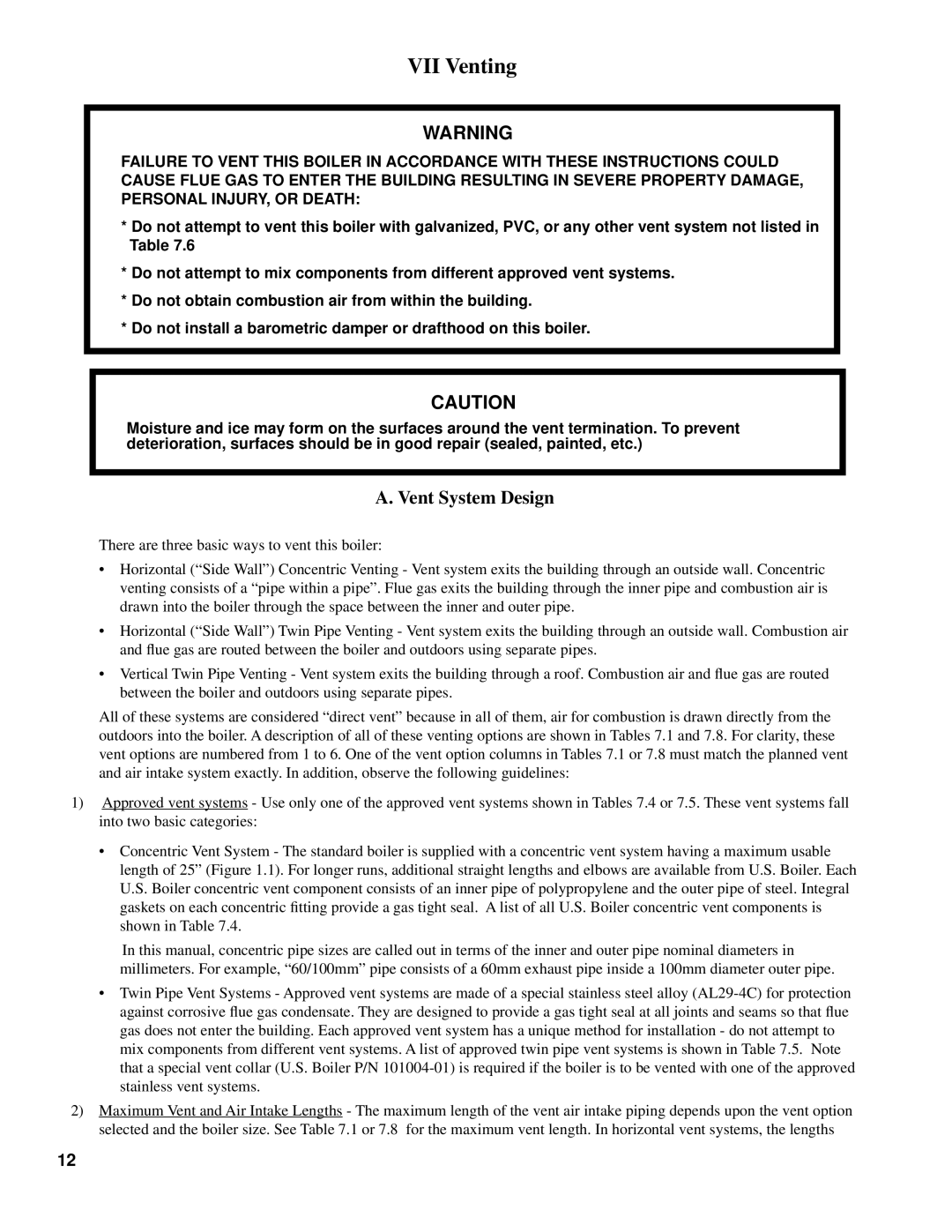
VII Venting
WARNING
FAILURE TO VENT THIS BOILER IN ACCORDANCE WITH THESE INSTRUCTIONS COULD CAUSE FLUE GAS TO ENTER THE BUILDING RESULTING IN SEVERE PROPERTY DAMAGE, PERSONAL INJURY, OR DEATH:
*Do not attempt to vent this boiler with galvanized, PVC, or any other vent system not listed in Table 7.6
*Do not attempt to mix components from different approved vent systems.
*Do not obtain combustion air from within the building.
*Do not install a barometric damper or drafthood on this boiler.
CAUTION
Moisture and ice may form on the surfaces around the vent termination. To prevent deterioration, surfaces should be in good repair (sealed, painted, etc.)
A. Vent System Design
There are three basic ways to vent this boiler:
•Horizontal (“Side Wall”) Concentric Venting - Vent system exits the building through an outside wall. Concentric venting consists of a “pipe within a pipe”. Flue gas exits the building through the inner pipe and combustion air is drawn into the boiler through the space between the inner and outer pipe.
•Horizontal (“Side Wall”) Twin Pipe Venting - Vent system exits the building through an outside wall. Combustion air and flue gas are routed between the boiler and outdoors using separate pipes.
•Vertical Twin Pipe Venting - Vent system exits the building through a roof. Combustion air and flue gas are routed between the boiler and outdoors using separate pipes.
All of these systems are considered “direct vent” because in all of them, air for combustion is drawn directly from the outdoors into the boiler. A description of all of these venting options are shown in Tables 7.1 and 7.8. For clarity, these vent options are numbered from 1 to 6. One of the vent option columns in Tables 7.1 or 7.8 must match the planned vent and air intake system exactly. In addition, observe the following guidelines:
1)Approved vent systems - Use only one of the approved vent systems shown in Tables 7.4 or 7.5. These vent systems fall into two basic categories:
•Concentric Vent System - The standard boiler is supplied with a concentric vent system having a maximum usable length of 25” (Figure 1.1). For longer runs, additional straight lengths and elbows are available from U.S. Boiler. Each U.S. Boiler concentric vent component consists of an inner pipe of polypropylene and the outer pipe of steel. Integral gaskets on each concentric fitting provide a gas tight seal. A list of all U.S. Boiler concentric vent components is shown in Table 7.4.
In this manual, concentric pipe sizes are called out in terms of the inner and outer pipe nominal diameters in millimeters. For example, “60/100mm” pipe consists of a 60mm exhaust pipe inside a 100mm diameter outer pipe.
•Twin Pipe Vent Systems - Approved vent systems are made of a special stainless steel alloy
2)Maximum Vent and Air Intake Lengths - The maximum length of the vent air intake piping depends upon the vent option selected and the boiler size. See Table 7.1 or 7.8 for the maximum vent length. In horizontal vent systems, the lengths
12
